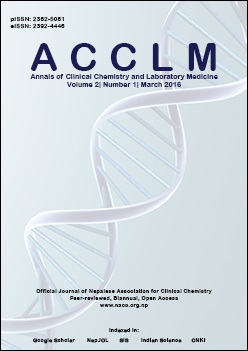Bacteriological Quality of Drinking Water Sources and Reservoirs Supplying Dharan Municipality of Nepal
DOI:
https://doi.org/10.3126/acclm.v2i1.14271Keywords:
Drinking water, fecal coliform, fecal streptococci, total coliform, total plate countAbstract
BACKGROUND: Nepal is one of the least developed countries and in most of the areas the water supplied directly from natural water sources (like streams, rivers etc.) is used for drinking purpose, without any prior treatment. So every year there are many water related outbreaks mainly in rainy season. Very little data is available about the bacteriological quality of the water from drinking water sources, in the country. This report presents a scenario of the bacteriological quality of the water from drinking water sources and reservoirs, supplying Dharan municipality of Nepal.
METHODS: Bacteriological analysis of the water samples was performed by membrane filter technique and spread plate technique. Total coliform count (TCC), fecal coliform count (FCC) and fecal streptococcal count (FSC) were performed by using membrane filter technique and total plate count (TPC) was performed by spread plate method.
RESULTS: Most of the sources and reservoir tanks were found to be heavily contaminated with heterotrophic bacteria, total coliforms, fecal coliforms and fecal streptococci. Contamination with more than one types of indicator organisms was common.
CONCLUSIONS: Most of the sources and reservoirs were found to be heavily contaminated with indicator organisms suggesting the alarming situation of water pollution in the area. Abrupt action is needed to be taken to improve the bacteriological quality of the water sources and reservoirs, supplying drinking water to Dharan municipality of Nepal.
Downloads
Downloads
Published
How to Cite
Issue
Section
License
Authors who publish with this journal agree to the following terms:
- The author transfers copyright to the Nepalese Association for Clinical Chemistry.
- The journal publishes the work under a Creative Commons Attribution License that allows others to share the work with an acknowledgement of the work's authorship and initial publication in this journal and under the same share-alike license used here.
- Authors are able to enter into separate, additional contractual arrangements for the non-exclusive distribution of the journal's published version of the work (e.g., post it to an institutional repository or publish it in a book), with an acknowledgement of its initial publication in this journal.
- Authors are permitted and encouraged to post their work online (e.g., in institutional repositories or on their website) prior to and during the submission process, as it can lead to productive exchanges, as well as earlier and greater citation of published work (See The Effect of Open Access).




